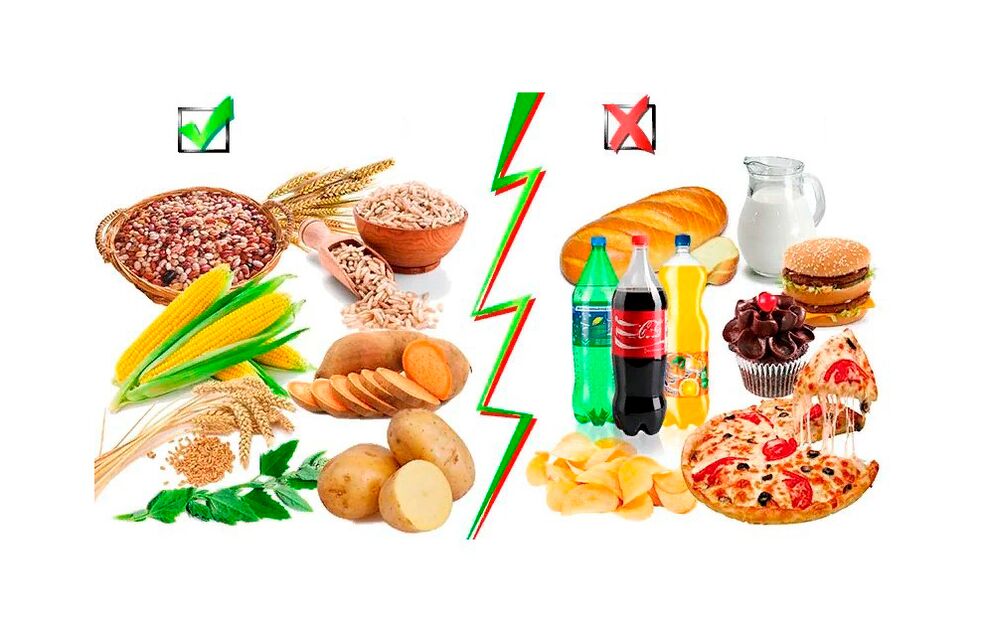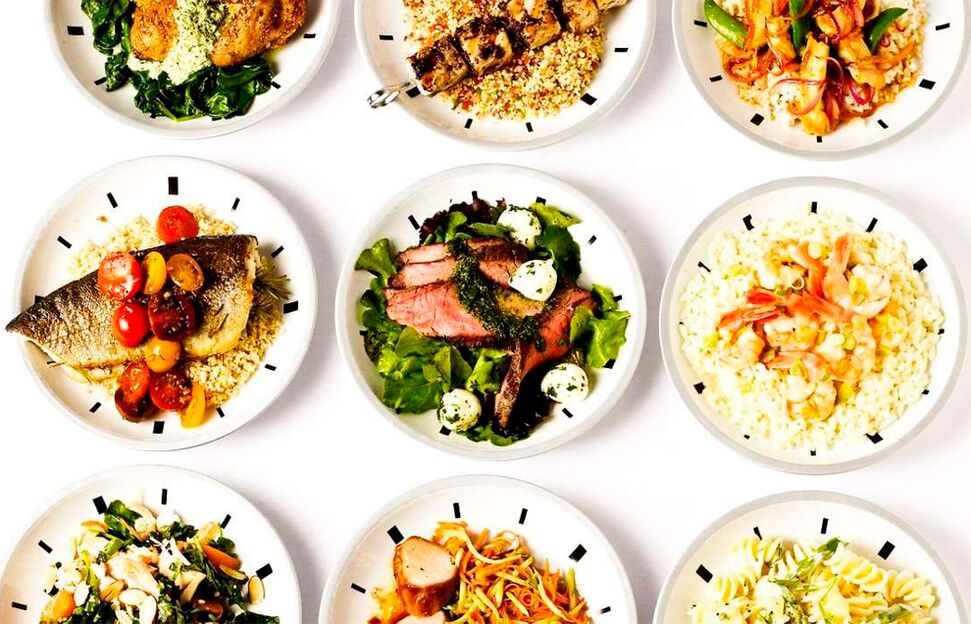A carbohydrate diet is an extreme version of a low-carbohydrate diet that focuses on protein, healthy fats, and fiber.
Our bodies often use carbohydrates (glucose) to provide energy to our bodies and brains. Their reduction leads to a decrease in the body's production of insulin, as a result of which it begins to break down protein (muscle stores) and stored fats as an alternative source. This leads to rapid weight loss.
Depending on age, weight, physical activity, and goals (weight loss, muscle mass, dehydration), the body needs different amounts of protein, fats, and carbohydrates (BJUs). According to experts, daily consumption is as follows:
- 45-65% carbohydrates
- Fat content 20-35%
- 10-35% protein
With a low-carb diet, fats become the main source of calories, and carbohydrates are reduced by 2-10%.

The general principles of a carbohydrate-free diet are:
- The amount of carbohydrates consumed is reduced from 0 to 30 grams per day.
- Remember to drink at least 8-12 glasses of water a day to remove toxins from the body.
- Since most diets are high in protein and fat, you need to consider their benefits. It is important to reduce the consumption of trans fats and not to overeat saturated ones. For example, a 2018 study suggests that low-carb diets that favor plant-based proteins and fats rather than animal sources are associated with lower mortality. Don't just think about shortening your waistline, think about your long-term health.
- It is almost impossible to completely give up carbohydrates because they are found in many foods. However, the first step is to avoid those with a glycemic index above 50.
The most popular type of low-carb diet is the keto diet, which has a BJU ratio of 75% fat, 20% protein and 5% carbohydrates. Also, the most famous and popular is the Dukan diet, which is the basis of a protein diet.
Advantages and disadvantages of a carbohydrate diet
Any diet is limited and stressful, so before experimenting with nutrition, you should evaluate all the pros and cons of your future regimen.
The benefits of a carbohydrate-free diet
- Replacing carbohydrates with proteins affects the hunger hormone ghrelin, which makes you feel full and helps reduce snacks and daily calories.
- Weight loss will be faster in the first few weeks. This is primarily due to dehydration. Carbohydrate-rich foods do not contain much water and are excreted through metabolism. For this reason, those who are trying to lose weight fast choose a carbohydrate-free diet. A study of 79 obese adults found that those who restricted carbohydrates to 30 grams per day for 6 months lost about 4 kg more than those who restricted fat.
- Carbohydrate intake has a significant effect on blood sugar and insulin levels. Excess glucose is associated with many health problems, such as type 2 diabetes, cancer, and cardiovascular disease. Low carb diets reduce the likelihood of this happening.
- Studies show that a carbohydrate-free diet can reduce the symptoms of Alzheimer's disease and slow its progression.
Disadvantages of a carbohydrate-free diet
- Decreasing the amount of carbohydrates consumed lowers insulin levels and increases the hormone glucagon, which leads to the burning of fat in the body. However, when the body switches to this type of fat burning, a process called ketosis occurs, and compounds called ketones are formed in the body. This process can cause nausea, headaches, halitosis, fever, and sleep disorders. In addition, fatigue and drowsiness are common. As a result, there are problems in everyday life, including a significant reduction in the number of trainings and a deterioration in the quality of their implementation.
- A low-carb diet will inevitably lead to a lack of fiber. Numerous studies show that the action of beneficial bacteria in the gut when eating dietary fiber is very important for overall health. Bacteria work on the fiber, forming short-chain fatty acids that inhibit the growth of harmful bacteria, maintain intestinal health, and have anti-inflammatory and antimicrobial effects. In addition, such a diet is difficult to provide the body with sufficient amounts of vitamins, especially B and C groups and minerals such as potassium.
- Long-term diet increases the risk of cholesterol, osteoporosis, heart rhythm disorders and kidney disease.
- The most common side effects of a carbohydrate-free diet are constipation or indigestion.
Who is not on a low carb diet?
- Patients with diabetes or chronic diseases that require close monitoring of blood sugar levels.
- People with diseases of the cardiovascular system, blood pressure and gastrointestinal tract.
- Pregnant and lactating women.
- Older people, adolescents and people with low body mass index.
- People with emotional or psychological problems related to food, including eating disorders.
Before embarking on a carbohydrate-free diet, consult a professional so that it does not harm you.
General guidelines for eating a carbohydrate-free diet
Low-carbohydrate foods include mainly fats: coconut, butter or oil, olive oil, avocado oil, etc.
While all fats and oils are 0 or minimal in carbohydrates, not all are healthy. Some oils are recycled and contain chemicals. In addition, most vegetable oils are high in omega-6 fatty acids, which can cause inflammation if used in excess. These fats can stop the anti-inflammatory activity of other fats such as omega-3.
For this reason, it is best to avoid fats that are high in omega-6 fatty acids, such as soy, corn, canola, and peanut oil.

Since the diet consists mainly of meat, which consists of protein and fats, make sure that it is of high quality and ideally organic, without additives, because their main purpose is to improve the taste and prolong the shelf life of the product. Try not to buy processed meat products. Many manufacturers add sugar, spices, and spices to increase the amount of carbohydrates.
Although dairy products contain carbohydrates (sugar in the form of lactose), in most cases they are insignificant. Sour milk can be used to obtain protein, calcium, vitamin D and potassium. Milk and yogurt are the most carbohydrates, but if you are not ready to cut them completely, it is important to choose products that are sweet or tasteless and control the number of servings.
Particular attention should be paid to food processing. Use recipes that include boiling, baking, and steaming to keep your diet going. Baking is useful. It is better to avoid fried foods altogether.
You should also choose foods with a low glycemic index (up to 50). They are slowly filled with carbohydrates, they break down for a long time and give a feeling of fullness. In general, it is important to keep in mind that fats come from high-calorie diets and sedentary lifestyles, not from carbohydrates.

What foods should be eaten and a carbohydrate-free diet should be avoided?
Low carb healthy foods
- Meat and low-carbohydrate animal products: chicken, beef, turkey, lamb, pork, eggs, butter, cheese
- Seafood: salmon, catfish, cod, shrimp, sardines, herring, anchovies, trout
- Spices: herbs and spices
- Low calorie drinks: water, black coffee and tea
- Nuts and seeds (low carbon): Almonds, walnuts, pumpkin seeds, sunflower seeds, pistachios, cashews
- Non-starchy fruits and vegetables rich in fat: broccoli, zucchini, bell peppers, eggplant, cucumbers, cauliflower, leafy vegetables, Brussels sprouts, celery, asparagus, mushrooms, coconut, avocado
Food should be avoided
A carbohydrate-free diet severely limits and includes several food groups:
- Cereals and grains: rice, barley, quinoa, wheat, bread, pasta
- Sweets and confectionery: cakes, cookies, candy
- Carbonated and carbonated beverages
- Fruits: apples, oranges, bananas, kiwis, pears
- Starchy vegetables: beans, corn, zucchini, potatoes
- Legumes: peas, chickpeas, lentils, beans
- Dairy products: milk and yogurt
- Spices with sugar: ketchup, barbecue sauce, salad dressing
- Alcohol: beer, wine, liqueur, sweet cocktails, port wine, vermouth
Carbohydrate-free menu for a week
Despite the fact that the list of available foods is considerably reduced, the diet can vary. An example of a daily carbohydrate-free diet menu.
Monday
Breakfast: omelet with mushrooms
Lunch: beef broth
Dinner: oven-baked Turkish fillet with asparagus
Tuesday
Breakfast: flax bread, guacamole and boiled eggs
Lunch: miso soup
Dinner: baked zucchini with cheese
Wednesday
Breakfast: salad with salmon and avocado
Lunch: soup with chicken cutlets
Dinner: pasta with bacon and sour cream sauce
Thursday
Breakfast: salad with chicken, cucumber, feta and spinach
Lunch: jacket noodles with cooked chicken cutlet
Dinner: pepper with seafood
Friday
Breakfast: a pot of cheese
Lunch: mushroom soup
Dinner: steak and greens
Saturday
Breakfast: eggs with bacon
Lunch: trout and brown rice
Dinner: boiled cabbage with meat
Sunday
Breakfast: oatmeal with a little almonds and a boiled egg
Lunch: boiled chicken with green beans
Dinner: seafood and green salad

Remember, a complete and long-term ban on carbohydrate use is very extreme and diet habits are not very good. Proper nutrition should include all the vitamins and nutrients needed for a balanced and effective functioning of the body. Experts have made various criticisms about low-carbohydrate and low-carbohydrate diets, but all agree that such a diet should be short-lived and should not be followed for more than 2 months.














































































